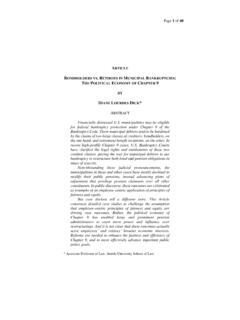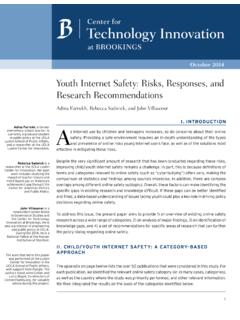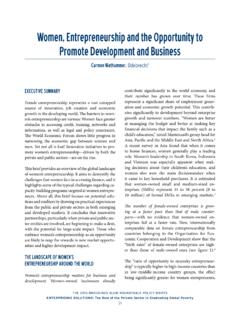Transcription of What happens if robots take the jobs? The impact of ...
1 1 What happens if robots take the jobs? The impact of emerging technologies on employment and public policyBy Darrell M. WestINTRODUCTIONI realized something dramatic was happening when my assistant Hillary came to me with an unusual experience. I had asked her to reschedule an appointment and she had emailed Amy, the personal assistant of the individual on my calendar. Amy was amazingly prompt in her follow-up. Hillary was on vacation and when Amy didn t get an immediate response, she emailed my assistant multiple times over the weekend trying to find a date that would It was only at this point that Hillary noticed Amy was a virtual assistant. Working for an artifi-cial intelligence firm that schedules meetings, Amy performed the tasks of a human assistant who read emails, discerned intent, and came up with a relevant response. Other than the artificial intelligence title on her signature line, and her extraordinary persistence and follow-through on weekends, there was nothing in the exchange that would have led anyone to conclude the correspondent was not reflecting on this experience, I realized that a virtual assistant trained in intelligent response is not a futuristic vision.
2 Rather, it is a current reality that performs quite well. This and other automated tools are no longer at the cutting edge of new technology. Rather, robots , artificial intelligence, computerized algorithms, mobile sensors, Darrell M. West is vice president and director of Governance Studies and founding director of the Center for Technology Innovation at Brookings. His studies include technology policy, electronic government, and mass media.[R]obots, artificial intelligence, computerized algorithms, mobile sensors, 3-D printing, and unmanned vehicles are here and transforming human life . People can decry these developments and worry about their dehumanizing impact , but we need to determine how emerging technologies are affecting employment and public policy. October 2015 What happens if robots take the jobs? 23-D printing, and unmanned vehicles are here and transforming human life . People can decry these developments and worry about their dehumanizing impact , but we need to determine how emerging technologies are affecting employment and public policy.
3 In this paper, I explore the impact of robots , artificial intelligence, and machine learning. In particular, I study the impact of these emerging technologies on the workforce and the provision of health benefits, pensions, and social insurance . If society needs fewer workers due to automation and robotics, and many social benefits are delivered through jobs, how are people outside the workforce for a lengthy period of time going to get health care and pensions? There are profound questions for public policy based on emerging technologies, the changing nature of the work-force, and the differential impact on various demographic groups. We need to reconfigure the social contract and figure out how to deliver social benefits in the new economy that is unfolding. Current approaches linked to full-time jobs will be insufficient if employment patterns change and society needs fewer workers to perform basic tasks.
4 We already have seen the impact of automation on blue-collar jobs and are starting to see its impact spread to white-collar jobs. As computers become more sophisticated, creative, and ver-satile, more jobs will be affected by technology and more positions made this situation, there have to be ways for people to get health care, pension, disability, and income supplements outside of full-time employment. Offering a basic income, revamping the earned income tax credit, providing activity accounts for lifetime education and retraining, expanding corporate profit-sharing, and providing benefit credits for worthy volunteerism represent ways to do this. We also need to reform school curricula so students aren t being trained for jobs that no longer exist and encourage continuing education and access to arts and culture for adults so they can expand their horizons throughout their lives. Advanced economies need to determine ways to avoid a permanent underclass with limited financial prospects or employment possibilities.
5 EMERGING TECHNOLOGIESThe list of new technologies grows every day. robots , augmented reality, algorithms, machine-to-machine commu-nications, 3-D printing, and autonomous vehicles help people with a range of different These technologies are broad-based in their scope and significant in their ability to transform existing businesses and personal lives. They have the potential to ease people s lives and improve their personal and business In his book, Pax Technica, political scientist Philip Howard outlines an empire of bits that is transforming how people interact with one Technology is becoming much more sophisticated and this is having a substantial impact on the are expanding in magnitude around the developed world. Figure 1 shows the numbers of industrial robots in operation globally and there has been a substantial increase in the past few years. In 2013, for example, there were an estimated million robots in use.
6 This total rose to around million in 2014 and is projected to increase to about million in Japan has the largest number with 306,700, followed by North America (237,400), China (182,300), South Korea (175,600), and Germany (175,200). Overall, robotics is expected to rise from a $15 billion sector now to $67 billion by What happens if robots take the jobs? 3 According to an RBC Global Asset Management study, the costs of robots and automation have fallen sub-stantially. It used to be that the high costs of industrial robots restricted their use to few high-wage industries like the auto industry. However, in recent years, the average costs of robots have fallen, and in a number of key industries in Asia, the cost of robots and the unit costs of low-wage labor are converging .. robots now represent a viable alternative to labor. 7 The Defense Advanced Research Projects Agency held a competition for a robot that could perform in hazardous environments.
7 robots were given eight tasks such as driving a vehicle, opening a door, operating a portable drill, turning a vale and climbing stairs. 8 The goal was to have equipment that could operate in damaged nuclear reactors or disaster scenes too dangerous for humans to operate. A Korean team won the competition (with a $2 million first prize) for completing these the contemporary world, there are many robots that perform complex functions. According to a presentation on robots , the early 21st century saw the first wave of companionable social robots . They were small cute pets like AIBO, Pleo, and Paro. As robotics become more sophisticated, thanks largely to the smart phone, a new wave of social robots has started, with humanoids Pepper and Jimmy and the mirror-like Jibo, as well as Geppetto Avatars software robot, Sophie. A key factor in a robot s ability to be social is their ability to correctly understand and respond to people s speech and the underlying context or emotion.
8 9 These machines are capable of creative actions. Anthropologist Eitan Wilf of Hebrew University of Jerusalem says that sociable robots represent a cultural resource for negotiating problems of intentionality. 10 He describes a jazz-improvising humanoid robot marimba player that can interpret music context and respond creatively to improvisations on the part of other performers. Designers can put it with a jazz band, and the robot will ad lib seamlessly with the rest of the group. If someone were listening to the music, that person could not discern the human from the robot performer. In Japan, there is a new hotel called Henn-na that uses robots to check people in and escort guests to their rooms. The robotic receptionist speaks Japanese or English, depending on the preferences of the guest. It can set up the reservations for people, take them to their rooms, and adjust the accommodation s temperature.
9 Within the room, guests can use voice commands to alter the lighting and ask questions regarding the time or has organized a picking challenge designed to see if robots can autonomously grab items from a shelf and place them in a tub. The firm has around 50,000 people working in its warehouses and it wants to see if robots can perform the tasks of selecting items and moving them around the warehouse. During the competition, a Berlin robot successfully completed ten of the twelve tasks. To move goods around the facility, the company already uses 15,000 robots and it expects to purchase additional ones in the millionFigure 1: Number of Industrial robots Around the WorldWhat happens if robots take the jobs? 4In the restaurant industry, firms are using technology to remove humans from parts of food delivery. Some places, for example, are using tablets that allow customers to order directly from the kitchen with no requirement of talking to a waiter or waitress.
10 Others enable people to pay directly, obviating the need for cashiers. Still others tell chefs how much of an ingredient to add to a dish, which cuts down on food experimentalists are using a robot known as Nao to help people deal with stress. In a pilot project called Stress Game, Thi-Hai-Ha Dang and Adriana Tapus subject people to a board game where they have to collect as many hand objects as they can. During the test, stress is altered through game difficulty and noises when errors are made. The individuals are wired to a heart monitor so that Nao can help people deal with stress. When the robot feels human stress levels increasing, it provides coaching designed to decrease the tension. Depending on the situation, it can respond in empathetic, encouraging, or challenging ways. In this way, the robot with personality is able to provide dynamic feedback to the experimental subjects and help them deal with tense COMPUTERIZED ALGORITHMST here are computerized algorithms that have taken the place of human transactions.
















